Abstract
The development of large coal power plants is often accompanied by environmental pollution, thereby influencing the lives of the surrounding residents, resulting in a “not-in-my-backyard” effect and associated social injustice. To mitigate these influences, we conducted field research and questionnaire surveys with individuals living in areas around the Xilinhot coal power plant to explore their cognitive and behavioral psychological changes in response to the environmental risks of the coal power plant and the factors influencing such changes. A “cognition-perception-behavior” model was constructed for residents coping with the ecological environment influenced by the development of the coal power plant. Cognition of eco-environmental risks had a significant effect on the perception of eco-environmental risks which, in turn, significantly promoted the adoption of adaptive behaviors. Residents had a strong cognition and perception of eco-environmental risks but an extremely low likelihood of adopting relevant adaptive behaviors. Thus, affective responses can increase the residents’ cognition and perception of eco-environmental risks, and the communication of risk information can help them evaluate eco-environmental risks rationally.
1. Introduction
Issues in the energy industry have gradually become highly discussed topics related to the economic development of China. However, China is in the development stage of new energy technology; hence, coal will continue to be the main energy source in China for the foreseeable future [1]. Over the years, China has been accelerating the development of large coal power plants to meet its strategic energy needs [2]. There are fourteen large 100-million-ton coal plants, namely Shendong, northern Shaanxi, Huanglong, northern Shanxi, central Shanxi, eastern Shanxi, western Shandong, Huainan and Huaibei, central Hebei, Henan, Yunnan, Guizhou, eastern Inner Mongolia, and Ningdong coal plants, which comprise 98 mining areas [3]. These coal plants have become important pillars for the development of China’s coal power industry. In 2020, the power production of these coal plants accounted for 95% of the total power produced in China. The technologies used in the coal power industry are becoming increasingly advanced. However, the construction of coal power plants has a significant impact on the environment, especially on surface water, groundwater, atmosphere, and soil [4]. Coal mining significantly damages the soil structure, threatening its function, pattern, and ecological stability. In addition, the slag produced in the mining process contains a large amount of heavy metals and organic pollutants, which are continuously released into the environment through weathering and rainwater erosion. Pollutants may contaminate crops or drinking water sources immediately after entering the soil or groundwater. Their toxicity and accumulation cause several direct and indirect hazards to human health. This aspect must be considered because the protection and improvement of the ecological environment is essential for the economic development of societies.
Raising public awareness of ecological practices helps promote good ecological behaviors and improve the civilized ecological system [5]. The study of the environmental cognition and behavior of residents around large coal power plants, who are the first victims of the environmental damage due to coal power development, is crucial for preserving the ecological environment.
With the popularization of Internet technology, risk communication between the media and public has become inevitable, and the public’s demand for the right to participate in risk management and the right to know has also increased accordingly [6]. Hu et al. [7] established a risk communication model based on the connotation of risk communication and introduced risk communication theory into risk management for the port environment of China based on an analysis of the experience and research progress of risk communication in the United States, Italy, and other developed countries. To understand the behavior of subjects, Ma et al. [8] constructed a psychological distance model to strengthen the individual cognition of environmental risks, guide environmental risk communication, and effectively help the public make independent and wise judgments in an informed manner. Nevertheless, public participation in environmental administration in China has problems of time lag, low participation rate, and inadequate institutions.
In this study, we investigated environmental risks and social psychology to analyze the impacts of environmental and social health and income on the environmental risks. A comparative investigation was conducted on the individual cognition and behavior related to the ecological environment. Measures and recommendations for eco-environmental risk communication were proposed based on the results of a questionnaire survey.
2. Cognitive and Behavioral Theories Related to Eco-Environmental Risks
2.1. Environmental Risk Perception
Environmental risk perception is a psychological phenomenon that underlies the way individuals perceive, adapt to, and act on their environment. Individuals often perceive and judge risk based on intuition, referred to as risk perception [9]. The study of environmental risk perception focuses on how individuals can recognize their surroundings, what impressions their surroundings and changes in the environment will produce in their minds, and how to apply such impressions to the environment. The consciousness and behavior induced by environmental risks are complex and contradictory [10]. Residents’ cognition of environmental risks originates from their feelings and knowledge. The negative environmental effects of the development and operation of large coal power plants, including soil erosion, regional ecological degradation, and increasing pollution in the surrounding areas, directly or indirectly affect the residents’ cognition of the environment and their psychological changes. Previous studies show that the cognitive awareness of residents in Wuhan, Hubei Province is relatively weak, and that the risk perception level is medium to low [11]. In addition, the relationship between cognition and behavior is complex [12] and is usually influenced by the two main characteristics of individuals, namely age and gender, and social factors.
2.2. Application of Cognitive Theories Related to Eco-Environmental Risks
Following environmental changes, individuals experience psychological changes mainly based on their cognition, perception, mitigating behavior, and adaptive behavior. The involved factors are correlated along this behavioral path, and a suitable response theory model can be realized. Individuals’ behavior is controlled by the social system, and individuals lack spontaneous cognition and perception of environmental risks. Analyzing the “cognition-perception-behavior” path helps to promote the adaptation of individuals to environmental changes.
In the process of environmental risk perception, relevant knowledge is crucial, and teaching the basics of environmental science is thought to be useful for environmental cognition [13]. Popular science education on the environment is usually a means of disseminating relevant scientific knowledge and cognition to introduce, explain, and popularize environmental science and technology to the public. For certain existing pollution phenomena, residents around pollution sources fail to recognize the risks to the environment in a timely manner because of little knowledge or the misunderstanding of the potential risks. As a result, they cannot make the correct decisions to prevent and control the spread of pollution over time, which may lead to more serious pollution. When residents lack basic knowledge and direct experience, environmental information conveyed by the media can greatly influence the public’s perception and cognition of the environment. Internet use can also influence citizens’ perception of the environment [14]. On the one hand, the Internet enables people to be more involved in environmental protection. On the other hand, the emotions triggered by the media may become the driving force, leading to unreasonable public decisions. Studies have shown that the longer individuals spend time online, the less they trust the government, and the lower their compliance level [15].
2.3. Eco-Environmental Risks from Large Coal Power Plants and Government Policies
The government is the main environmental information provider and authority for environmental information disclosure. The government’s proactive disclosure of environmental information is an important guarantee for strengthening the public’s knowledge and satisfying the public’s right to influence environmental policies [16]. On 30 October 2001, the United Nations Environment Programme (UNEP) published the Convention on Access to Information, Public Participation in Decision-making, and Access to Justice in Environmental Matters, which is known as the Aarhus Convention. This convention entitles the public to rights and imposes obligations on parties and governments in the areas of access to information, public participation, and access to justice [17]. In 2008, the former State Environmental Protection Administration (SEPA) of China issued the Measures on Environmental Information Disclosure (Trial), which marked the beginning of China’s environmental information disclosure system. These measures have stimulated the public’s environmental awareness and strengthened the supervision over the government’s exercise of power. The disclosure of environmental information makes it easier for the public to obtain accurate environmental information. The Green Mine Construction Specification of Coal Industry (DZ/T0315-2018), which formally came into effect in 2018, recommends the principle of “extraction, governance, and recovery at the same time” [18]. Since the publication of this twenty-five-year plan, environmental protection departments have been proactive in making environmental information public in a timely manner. Because of this effort, air and water quality information is proactively disclosed, environmental information closely related to people’s livelihoods has become easily accessible, enterprises performing illegal sewage practices are exposed, and a public pollution source reporting hotline has been established [19]. In 2019, the Ministry of Ecology and Environment of China published the Measures for the Implementation of Government Information Disclosure by the Ministry of Ecology and Environment to further ensure the access of citizens, legal entities, and other organizations to the government information of the Ministry of Ecology and Environment in accordance with the laws and regulations; this has improved the transparency of government work and promoted the establishment of a law-based government. This policy aims to promote the use of the government’s eco-environmental information for improving people’s quality of life and economic and social activities. However, the information disclosure system and public participation channels in China have several problems, including untimely disclosure of information, a single form of disclosure, and low applicability of public participation system [20].
3. Methodology
3.1. Ecological Environment Risk Perception Path
Humans exchange and transmit information to the environment through cognition and perception. When the surrounding environment changes, people change their consciousness to cause cognitive and conscious psychological changes, which will further lead to changes in behavior. The eco-environmental risk cognitive path refers to the behavior of the public in response to specific environmental problems in a certain context [21]. Cognition, perception, and behavior are successive and interconnected. People’s behavior is also controlled by the social system, including the media and the sense of social and political participation. Generally, residents with a stronger perception of environmental risks will provide more behavioral feedback to avoid harm from environmental problems. Therefore, the analysis of the cognition-perception-behavior path helps to better respond to changes in the environment.
In the early 1980s, researchers outside China began to use the risk perception method to explore the risk factors that affect people’s social lives and to understand people’s attitudes toward risks [22]. In this study, we investigated the cognition-perception-behavior structure and its relation to the ecological environment as a process of behavioral psychological change of individuals in response to the ecological environment around a coal power plant. We focused on the path relationship between individuals’ cognition of eco-environmental risks due to large coal power plants, perception of the impacts, and adaptive behavior as well as the influence of individual characteristics and information acquisition. The results of this study are expected to guide decision-making to cope with eco-environmental risks.
3.2. Case Study
The Xilingol League is one of three leagues of Inner Mongolia, located in the city of Xilinhot, which is 640 and 620 km away from Beijing, China, and Hohhot, Inner Mongolia, respectively. It is an important livestock area and the frontier of China’s Western Development Policy; it is a pastoral grassland area which is nearest to Beijing, Tianjin, and Hebei.
Owing to the depletion of energy resources in the central and eastern areas of China, the country is gradually shifting its strategic center of coal power development to the western area. The Inner Mongolia energy plant is now gradually becoming the main coal power supply and national strategic energy plant to support China’s long-term economic and social development [23]. However, in recent years, grasslands have deteriorated, their grassland ecosystem has been destroyed, and their surface area has decreased. Although grassland is the dominant landscape, the area and dominance of grasslands are decreasing and are becoming increasingly fragmented. Meanwhile, the area, dominance, and continuity of the mine dump, industrial and mining warehouses, mining pits, and washing ponds in the mining operation area are increasing.
The Wulantuga open-cast germanium coal mine is located in Xilinhot City, Xilingol League, Inner Mongolia. The Eastern Grassland Coal Power Plant is located in the eastern part of Inner Mongolia, in the northern sand belt and in the northern part of the national ecological pattern of “two barriers and three belts” [24]. The primary type of soil in Xilingol League is chestnut soil, and the vegetation type is typical grassland; the vegetation covers approximately 50% of the total area. This coal power plant is mainly subjected to wind erosion with intermittent water erosion [25]. In recent years, environmental problems due to open-cast mines have also become prominent. For example, the development of coal mines has resulted in the decrease in water levels and a higher speed of blown sand; natural grasslands in nearby areas have been destroyed by heavy dust cover, resulting in the formation of bare surfaces and desertification of land. Furthermore, changes in ground stress due to open-pit excavation have led to the movement of rock strata and collapse of the ground surface, rendering large areas of land unusable [26]. Severe environmental pollution has also affected the health of the surrounding population to varying degrees; for example, the incidence of pneumonia infection has increased. A questionnaire survey was conducted on the employees of Shenhua and Datang in Xilinhot City. The survey locations were: Shenhua Energy Building, Shengli and Tangyun Community. Household questionnaires were completed by herder families in the above three villages and herder concentration areas in the urban space: Herders Xinyuan: A questionnaire survey of urban residents, survey locations: Beizi Temple Square (Northeast), Xilin Square (Southeast), and Wetland Park (Southwest), the location map is shown in Figure 1.
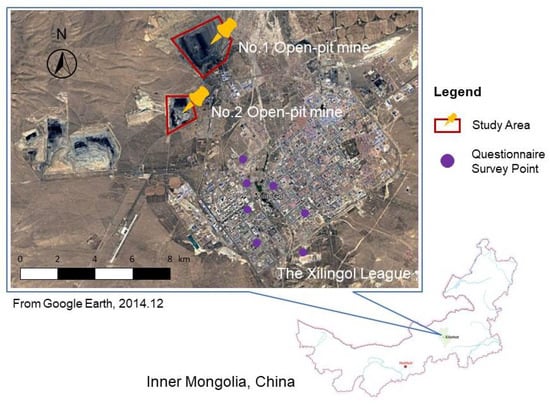
Figure 1.
Survey mine area location map.
3.3. Questionnaire Design
The purpose of the questionnaire was to maintain, protect, and evaluate the health and ecological service functions of open-cast mines and their surrounding ecosystems. The questionnaire was designed based on the maturity scales of prior research on “cognition and behavior” and “information seeking and processing” through a fundamental survey and evaluation of the environmental cognition and perception of the residents about the open-cast mine [27]. By dividing the hypothetical model and the relevant influencing factors into components, we set the questions in terms of basic personal information, eco-environmental awareness, adaptive behavior, and satisfaction with mitigating behaviors. The answers to each question were quantified according to a scale developed by American social psychologists. For example, regarding the degree of quantification, “1” represents “do not know any relevant knowledge,” “3” stands for “know less relevant knowledge,” and “5” stands for “know all relevant knowledge”; regarding quantification of opinions, “1” stands for “strongly disagree,” “3” stands for “neither agree nor disagree,” and “5” stands for “strongly agree.”
A total of 227 questionnaires were distributed, among which 206, or 90.7%, were valid. Cronbach’s alpha (also known as coefficient alpha, α) was used as the reliability coefficient in this questionnaire. The coefficient of the questionnaire was 0–0.70 (unacceptable value) and 0.70–0.80 (acceptable). The sample reliability analysis showed that the overall data calculation results of the questionnaire met the criterion of α > 0.7, indicating that the questionnaire was highly reliable and had applicable results.
3.4. Structural Equation Modeling
Structural equation modeling (SEM), also known as covariance structural modeling, has been gradually developed based on factor analysis and path analysis through fusion analysis and superposition [28]. SEM integrates various methods, namely multiple regression, path analysis, factor analysis, and covariance analysis, to clearly analyze the role of a single variable and clarify the relationship between variables. SEM can solve complex internal relationship problems that cannot be solved by a single analytical method and can be used for the validation, revision, and construction of hypothetical models.
SEM was first proposed at the beginning of the 20th century, and with the application of various social psychology models, it became improved and was increasingly applied to various fields in the 1960s. However, few researchers in China understood and were familiar with SEM at that time. In the 1990s, SEM was first applied to psychological research in China. Since then, SEM has been applied in various fields and has developed rapidly. Today, SEM is a cutting-edge analysis and theoretical validation method in mathematical statistics [29].
Furthermore, it has a wide range of applications in other fields. For example, in public services, researchers combine structural equation modeling and least-squares to measure public transport passenger satisfaction. Combined with the characteristics of public transportation services in the United States, the American customer satisfaction theory was revised. Additionally, a conceptual model of the Passenger Satisfaction Index (PSI) was constructed [30] to examine the coordination between urban construction and district-level population density and deepen the balanced development of urban scale. Nine variables were selected to promote better implementation of planning policies. This was performed by combining structural equation modeling (SEM) with stepwise multiple linear regression (SMLR) to form an exploratory SEM analysis framework. Additionally, the significance of variables and their interactions were analyzed to discover the uneven distribution of public service facilities and public transportation [31].
In this study, a structural equation model was employed to validate the overall hypothetical cognition-perception-behavior structure based on the questionnaire analysis. We hypothesized that changes in the ecological environment around the large coal power plant would induce respondents to adopt adaptive behaviors. In the model, changes in the ecological environment, including climatic changes, blown-sand intensification, and pollution of environmental elements were the observed variables. The respondents’ cognition of eco-environmental risks, that is, whether the respondents’ awareness changed due to eco-environmental changes, was a potential variable.
3.5. Cognition–Perception–Behavior Structural Equation Model
The theoretical framework of this study is based on the three-stage theory proposed by Lorenzoni et al. [32], which assumes that an individual’s behavioral psychological process while engaging in the ecological environment comprises of three stages: awareness of eco-environmental changes, perception of the impacts of the changes, and adaptation through an appropriate behavior.
Based on the procedure proposed by Grothmann and Patt [33], we determined the relationship between perception and adaptive behavior. Hou and Liu [34] identified the path relationship of “cognition-perception-mitigating behavior and adaptive behavior.” In this study, eco-environmental risk cognition refers to the residents’ cognition of the risks from changes in the surrounding ecological environment under the influence of large-scale coal power plant development; eco-environmental risk perception refers to the residents’ perception of the impacts of eco-environmental changes on their health, daily life, incomes, and other personal aspects after the eco-environmental changes; mitigating behavior refers to the behavior adopted by residents to mitigate eco-environmental risks after the eco-environmental changes; adaptive behavior refers to the behavior adopted by residents to cope with changes in the ecological environment. We hypothesized that the cognition-perception-behavior process is an individual’s behavioral psychological process adopted when engaging with the ecological environment during the construction of a coal power plant. In other words, the surrounding residents’ cognition of eco-environmental risks influences their perception of the impact of these risks, which in turn influences their adaptive behavior.
4. Analysis of Questionnaire Results
4.1. Analysis of Respondents’ Personal Characteristics
Table 1 presents the personal characteristics of the respondents influencing the acquisition of eco-environmental risk information and affective responses. Correlation coefficients were obtained through correlation analysis based on the statistical product and service solutions. The values of the correlation coefficients indicated that the adequacy of eco-environmental information was positively correlated with educational background, employment status, and annual household income. In other words, an individual with a higher educational background, better employment status, or higher annual household income would obtain more adequate ecological information.

Table 1.
Correlation coefficient and significant level of correlation of eco-environmental risk information acquisition and affective response with personal characteristics.
Concerning the eco-environmental risks from the construction of large coal power plants, respondents’ concerns, anger, and uncertainty were significantly influenced by ethnicity, employment status, and length of residence, and the correlation signs were consistent. The affective response was positively correlated with ethnicity: Mongolians were more likely to be emotionally responsive. Affective responses were negatively correlated with employment status and positively correlated with length of residence: residents with longer local residences were more likely to be emotionally responsive. Anger was more easily influenced by the length of residence than concern and uncertainty.
This survey includes people from industrial and pastoral herders, urban residents, and coal-fired power employees. Due to introducing the enclosure and transfer strategy in 2002, Xilinhot’s agricultural production and management methods have changed. For 5.8% of the total sample, there are very few migrant workers, only 1%. Urban residents generally have other occupations or go to school, 32.5% and 12.5% respectively (Figure 2). Therefore, we divided the sample into three categories: pasture herders, coal-fired power staff, and other occupations to classify and analyze the remaining personal characteristics. The three categories account for 18.9%, 56.8%, and 24.3%, respectively (Figure 3).
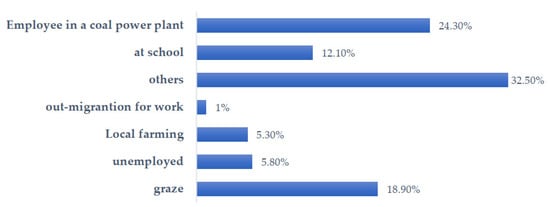
Figure 2.
Employment status of respondents.
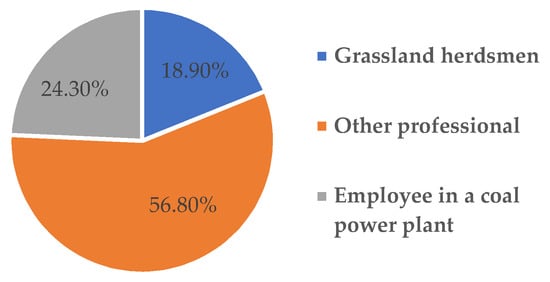
Figure 3.
Classification of employment status of respondents.
Figure 4 shows the distribution of the respondents’ educational backgrounds. All coal power staff have a high-education background, all with a high school degree or above. The majority of them have a bachelor’s degree or above, accounting for 80% of the total number of employees, of which 8% have a master’s degree or above. Further, accounting for 31%, only 23% of herders have a bachelor’s degree or above. The distribution of other occupations was relatively even. A bachelor’s degree or above accounts for 40% of the total, of which 3% are master’s or above. The three types of vocational education have a large gap, and the educational background is an essential component in the follow-up research on related factors of cognitive behavior.
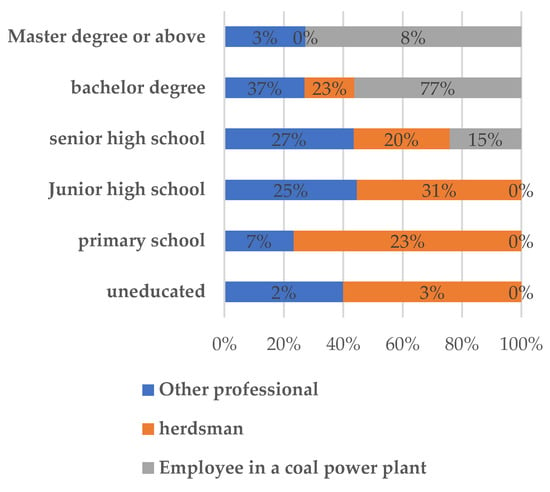
Figure 4.
Educational background of respondents.
4.2. Cognition of Eco-Environmental Risks during Construction of Large Coal Power Plant
In the context of the development of a large coal power plant, cognition of eco-environmental risks refers to the process whereby an individual becomes aware of eco-environmental risks, including climatic changes, eco-environmental changes, and environmental pollution.
Table 2 lists the changes in the local climatic dryness and coldness that residents are aware of. It can be seen that a large proportion of the local respondents were aware of an increase in the climatic dryness, but relatively few were aware of the changes in climatic coldness. Some of them neither agreed nor disagreed with the change, that is, they were not obviously aware of the change in climatic coldness. It can also be seen that the majority of the respondents were aware of changes in the local ecological environment, unlike changes in climatic dryness and coldness. This indicates that people become more easily aware of changes in the ecological environment than changes in climatic dryness and coldness.

Table 2.
Cognition of respondents to the change in the local environment.
Figure 5 shows the respondents’ awareness of specific eco-environmental damages. The vast majority of the respondents were aware of ecological damage. In particular, respondents were more likely to be aware of sand degradation and pasture destruction.
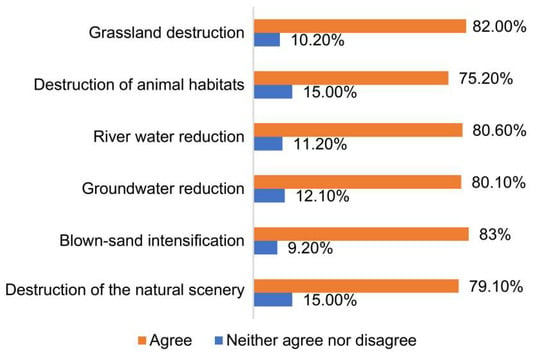
Figure 5.
Respondents’ awareness of specific eco-environmental damage phenomena.
4.3. Perception of Impacts of Eco-Environmental Risks during Construction of Large Coal Power Plant
In the context of the development of a large coal power plant, perception of eco-environmental risks refers to the process whereby an individual perceives the impacts of eco-environmental risks on himself/herself, including the impact on life, health, work, and income.
Table 3 depicts the respondents’ perceptions of the impacts of changes in the surrounding ecological environment due to the construction of a large coal power plant. It can be observed that a smaller proportion of respondents perceived the impacts of eco-environmental changes on educational issues than on physical health and transportation issues.

Table 3.
Respondents’ perception of the impacts of changes in the ecological environment.
Coal power development influences human health mainly through sand and dust suspension and migration, transformation of heavy metals in soil and groundwater, and biological enrichment in plants and animals in grasslands. Some studies have shown that arsenic has the largest hazard coefficient in terms of the ecological risk of heavy metal pollution in Xilinhot, and its ecological risk level is moderate [35]. Respondents perceived the health risks of coal power development mainly through grassland dust, discoloration of water sedimentation, livestock lung disease, and childhood lung disease. The perceived impact on traffic manifests itself in the change of straight roads to bypass roads due to coal power development. In terms of the perceived impact on education, we found that some schools are relocated because of coal power development; as a result, students may experience longer travel times to school.
Herdsmen (mainly herding sheep and goats) are the most vulnerable group as their income was influenced the most by coal power development. They primarily derived their income from the sale of lambs. Ecological damage leads to a decline in pasture production, making it difficult for herders to maintain their livelihood. In addition, the implementation of ecological environment mitigation policies, such as grazing resting, prohibition, and grass storage balance, prevents most herders to continue grazing. Moreover, the development of coal power enterprises does not increase employment for herders [36].
4.4. Adaptive Behavior in Response to Eco-Environmental Risks during Construction of Large Coal Power Plant
In the context of the development of a large coal power plant, adaptive behavior refers to the process whereby an individual adopts adaptive behavior to cope with eco-environmental risks to livelihood and income.
The life-adaptive behavior to cope with health risks generally includes reducing activities near roads along coal mines and transmission systems, wearing a mask, using an air purifier, drinking bottled water, using a water purifier, sleeping with earplugs, soundproofing the house, changing transportation tools, changing jobs, and moving houses. There are generally six types of work-adaptive behavior to cope with impacts on income: seeking compensation from coal power companies, seeking jobs from coal power companies, seeking compensation from the government, seeking jobs from the government, seeking re-employment on their own, and starting their own business.
Figure 6 and Figure 7 illustrate the life and work-adaptive behaviors of residents, respectively, in response to eco-environmental risks. Among life-adaptive behaviors, respondents usually chose less costly adaptive behaviors, such as wearing a mask, using a water purifier, reducing activities near a coal mine, and drinking bottled water. Fewer respondents chose costly or cumbersome life-adaptive behaviors, such as soundproofing the house or changing job or transportation tool; sleeping with earplugs was chosen by the lowest number of respondents. Among work-adaptive behaviors, respondents were more likely to seek re-employment and start their own business, followed by seeking compensation from the government or coal power companies. This result shows that most respondents mainly adapted to environmental risks by making their own changes, and a minority of respondents relied on companies and the government. In this survey, 59.7% of the respondents did not adopt work-adaptive behaviors.
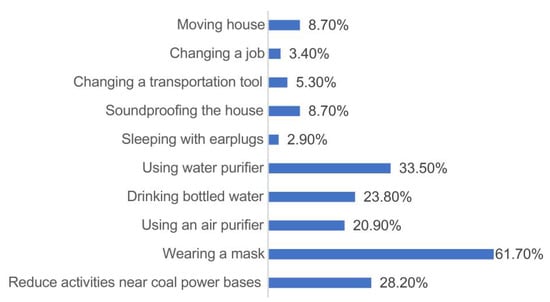
Figure 6.
Residents’ life-adaptive behavior.

Figure 7.
Residents’ work-adaptive behavior.
Respondents were highly likely to adopt life-adaptive behaviors. The probability of perceiving the impact on work was only slightly lower than the probability of perceiving the impact on some life activities. The probability of perceiving impacts on all activities was higher than the rate of adoption of adaptive behavior. People around a coal power plant seem to lack the willingness to adopt adaptive behavior when their health, life, work, and income are threatened. Furthermore, 17 percent of the respondents did not adopt life adaptation behaviors. People in vulnerable groups lack the knowledge and ability to adopt work-adaptive behaviors [37].
Residents’ adoption rate of ecological environment adaptation behaviors is generally meager, contrasting their ecological environment risk perception and perception effects. This is related to the residents’ lack of knowledge, ability, or awareness to implement adaptive behaviors. It may also be their trust in the government and mitigation behaviors. Finally, it is caused by higher participation and satisfaction.
Factor analysis is a small number of “abstract” variables obtained by principal component dimensionality reduction analysis. Latent variables, instead of a large number of obvious variables, represent the basic structure of the overall data. Moreover, the resulting matrix can reflect that each obvious variable corresponds to the load capacity’s latent variable. This study mainly performed factor analysis on behavior-related multiple-choice items. Through principal component analysis, the factor load after the maximum variance method was obtained. We have numbered life adaptation behavior and work adaptation behavior, as shown in Table 4.

Table 4.
Eco-environmental risk adaptation behavior in coal-fired power development.
The principal component extraction factor analysis method was used to classify the individual’s life adaptation behavior in response to health risks and the individual’s work adaptation behavior in response to income impact. The maximum variance rotation matrix loading results are shown in Table 5.

Table 5.
Factor analysis of ecological environment risk adaptation behavior.
The analysis result of the life adaptation behavior factor KMO ≥ 0.600, 0.664 was in line with the Bartlett sphericity test, was reliable, and p < 0.001 indicates a significant correlation of variables. Furthermore, three principal components with characteristic roots greater than 1 were identified based on principal component analysis. The cumulative variance contribution rate of the rotation matrix >60%, 60%, that is 66.590%—the data loss was slight.
The KMO > 0.6 of the life adaptation behavior factor analysis result was 0.679, in line with the Bartlett sphericity test. Thus, the result is reliable, and p < 0.001 indicates that the variable correlation is significant. Based on the principal component analysis, two principal components with characteristic roots greater than 1 were identified and rotated. The matrix cumulative variance contribution rate was >60%; that is 64.240%—the data loss was slight.
4.5. Satisfaction of Ecological Environment Risk Mitigation Behavior
In large-scale coal power development, ecological, environmental risk mitigation behavior refers to the process of mitigating behaviors that mitigate ecological, environmental changes in the face of ecological, environmental risks. This includes (1) ecological, environmental mitigation behaviors of coal power companies and (2) government-led ecological, environmental mitigation behaviors.
There are seven strategies for ecological environment mitigation behaviors of coal mining enterprises and two strategies for government-led ecological environment mitigation behaviors. The specific behaviors and numbers are shown in Table 6 below.

Table 6.
Eco-environmental mitigation behaviors in coal-fired power development.
Residents’ satisfaction with the ecological environment mitigation behavior adopted by coal power companies is shown in Figure 8. Again, most of them have better results and general attitudes.
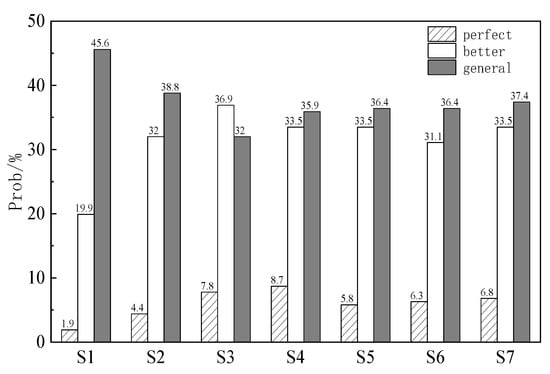
Figure 8.
Satisfaction degree of residents’ eco-environmental mitigation behavior in coal-fired power enterprises.
Residents’ satisfaction with the government’s ecological environment mitigation policies is shown in Figure 9. From comparing the satisfaction of the three effects, the public is more satisfied with no grazing and prohibition of grazing (M1). This is related to the growth environment of the prairie people. People who grew up on the prairie regard it as their homeland. Additionally, they have doubts about the ecological migration (M2) policy. Compared with Figure 8, the residents’ satisfaction with the government’s ecological environment mitigation policies and the more satisfactory mitigation behaviors of coal-fired power companies are slightly lower. This may be the result of the mitigation behaviors being more direct than the mitigation policies, and the implementation and effects appear faster. When people are unsure about the consequences of behavioral policies, people tend to resist policies.
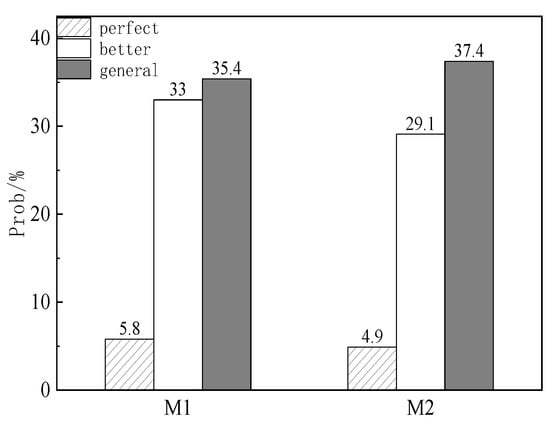
Figure 9.
Residents’ satisfaction with the government’s eco-environmental mitigation policy.
5. Principal Component Analysis and Structural Equation Model
5.1. Model Assumptions
This study assumed that ecological environment risk perception-adaptive behavior is the psychological change process of individuals participating in the ecological environment behavior under coal power development. That is to say, the individual’s perception of ecological environment risk affects the individual’s perception of the impact of ecological environment risk, which in turn affects the ecological environment risk adaptation behavior decision. As shown in Figure 10, the theoretical framework is established in this research.
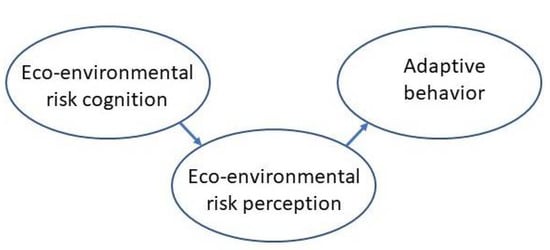
Figure 10.
Theoretical framework hypothesis.
(1) The individual’s perception of ecological environment risk has a positive effect on the perception of the impact of ecological environment risk; (2) The perception of the impact of individual ecological environmental risks has a positive effect on adaptive behavior.
This process is also affected by personal characteristics, information dissemination, emotion, and trust response. The research also focused on of the effects of different variables on cognition and perception, and behavior was also a focus of this research.
5.2. Structural Equation Model Validation
The theoretical framework for the study is based on the following assumptions: (1) Individual cognition of eco-environmental changes has a positive effect on the perception of the impacts of eco-environmental changes; (2) Individual perceptions of the impacts of eco-environmental changes have a positive effect on adaptive behavior in response to environmental changes.
We clarified the relationships between the variables to be analyzed and determined the initial hypothetical model. Figure 11 shows a diagram of the structural equation model drawn with AMOS 24.0 by extracting potential and observed variables.

Figure 11.
Structural equation model of eco-environmental risk cognition and behavior.
AMOS 24.0 was used to validate the structural equation model. Table 7 shows the results of the model indicators. The overall fit of the model was statistically significant (p = 0.048), and all fit indicators met the evaluation criteria, demonstrating the practical applicability of the hypotheses of the theoretical framework model constructed in this study.

Table 7.
Model test indicators and criteria.
5.3. Path Analysis of the Optimal Model
We analyzed the correlation of different paths of this structural equation model while allowing the model to satisfy statistical significance. Significance level * indicates p < 0.1; ** indicates p < 0.05; *** indicates p < 0.01. The standardized path coefficient indicates the degree of influence between variables.
5.3.1. Total Path Analysis
Total path analysis refers to the analysis of the degree of impact of the variables of the path “cognition of environmental risks-perception of risk characteristics-adoption of adaptive behavior.” The parameters involved are presented in Table 8.

Table 8.
Total path coefficient of the model.
The total path of the structural equation consisted of three potential variables, among which there were two direct correlations and one indirect correlation. The degrees of the direct and indirect correlations are listed in Table 9.

Table 9.
Direct and indirect correlations among the three potential variables.
The individuals’ cognition of eco-environmental risks significantly promoted the individuals’ perceptions of eco-environmental risk characteristics (p < 0.01), with an impact coefficient of approximately 0.97. This indicates that of 100 individuals that were aware of environmental degradation or pollution, 97 perceived the impact of environmental risks.
The individuals’ perceptions of environmental risk characteristics did not play a significant role in the adaptive behavior in response to the effects of environmental degradation (p > 0.05). The impact coefficient was approximately 0.28, indicating that of 100 individuals who perceived environmental risk characteristics, only 28 adapted to the environmental impacts.
The cognition of environmental risks had an indirect effect on the adoption of adaptive behavior with an impact coefficient of approximately 0.27. This indicates that of every 100 individuals who perceived environmental degradation or pollution, 27 adopted adaptive behavior to cope with environmental impacts.
5.3.2. Partial Path Analysis
Partial path analysis refers to the analysis of the correlation between partial path variables of cognition of environmental risks-perception of risk characteristics-adoption of adaptive behavior path. The involved parameters are listed in Table 10.

Table 10.
Partial path coefficients of the model.
Cognition of climatic change, cognition of ecological change, and cognition of environmental pollution had a significant impact on the cognition of environmental change (p < 0.01), with impact coefficients of approximately 0.58, 0.84, and 0.98, respectively (Figure 12). This indicates that the respondents’ cognition of ecological change and cognition of environmental pollution contributed more to the cognition of eco-environmental risks than their cognition of climatic change.
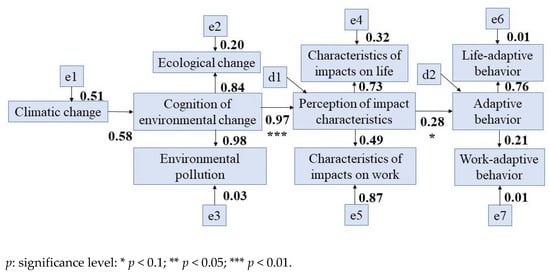
Figure 12.
Correlation coefficients of the cognition-perception-behavior structural equation model.
The perception of the characteristics of the impacts on both life and work had a significant impact on the perception of the risk characteristics (p < 0.01), with impact coefficients of approximately 0.73 and 0.49, respectively. This shows that the perception of the characteristics of the impacts on life contributed more to the perception of risk characteristics than the perception of the characteristics of the impacts on work.
Both life and work-adaptive behaviors had significant effects on the adaptive behavior (p < 0.1), with impact coefficients of approximately 0.76 and 0.21, respectively. This shows that life-adaptive behaviors contributed more to the adaptive behavior than work-adaptive behaviors.
Residents follow the cognitive and behavioral path of cognition of environmental risks-perception of the risk characteristics-adoption of adaptive behavior to cope with environmental risks. Owing to the low adoption rate of work-adaptive behaviors by residents, the model obtained a low correlation in the stage of “perception of risk characteristics → adoption of adaptive behavior.” Moreover, the willingness and ability of residents to adopt work-adaptive behavior were much lower than those to adopt life-adaptive behavior if the perception levels of the impacts on health and work did not vary significantly.
6. Conclusions and Recommendations
We used the cognition-perception-behavior structural equation model to analyze the eco-environmental changes due to the construction and operation of a large coal power plant and their impacts on the permanent residents living around the coal power plant in Xilinhot, Inner Mongolia. A field investigation and questionnaire survey were adopted for the research. A structural equation model was employed to reveal the path of cognition of eco-environmental risks among respondents. The following conclusions can be drawn: (1) Respondents were more likely to be aware of local environmental changes. Because eco-environmental changes directly or indirectly affect the daily life and work of the surrounding residents, it is easier for the residents to be aware of ecological damage, such as degradation of pastures, reduction in water resources, and intensification of blown wind. (2) According to the questionnaire survey results, nearly 50% of respondents perceived the impact of coal power development on themselves. The impact on life manifested itself mainly in the influence on residents’ health, whereas the impact on work manifested itself mainly in the influence on residents’ income. In addition, the impact on residents’ daily transportation was also an important contributor to the increased perception of impacts on life. (3) When the probability of both cognition and perception of eco-environmental risks was high, residents were less likely to adapt to the ecological environment. Although work-related adaptive behavior helps reduce individual sensitivity and increase adaptive capacity, residents are more likely to adopt adaptive behaviors that reduce their exposure to risks. This is because of their lack of relevant scientific knowledge, low personal capability, and low economic conditions [38]. (4) Regarding the residents’ satisfaction with the mitigating behavior to cope with eco-environmental risks from coal power development, most residents were either neutral on the mitigating behavior adopted by coal power enterprises and the government or regarded such behavior as effective. This is mainly because of the efforts of coal power enterprises to develop and implement the “three-simultaneous system” to ensure the simultaneous implementation of coal power development and environmental management [39]. In addition, the government is also creating conditions to make relocation easier.
The construction and operation of coal power plants involve various eco-environmental problems, such as destruction of vegetation, soil erosion, salinization, desertification of the land, and shrinkage and degradation of wetlands [40]. Based on the findings of this study, we make the following recommendations for the humane management of ecological restoration of coal power plants in terms of information communication and public participation. (1) Risk education can be strengthened through multiple channels. Risk education for coal power plants can be conducted in multiple real environments such as schools and communities as well as via the digital environment of the Internet in general. The education content should mainly include the current environmental problems, possible impacts of these problems, and local protection measures implemented by enterprises and governments. (2) Humane information release is recommended. The government, enterprises, research institutions, and the media, as the subjects of information release, should take the initiative to release ecological risk information, publish plans to ensure the ecological safety of coal power plants, and make forecasts on the reduction of future risks. (3) A full-process public participation mechanism is recommended. This mainly involves public participation in decision-making on the construction of coal power plants in the construction and operation phases. The main purpose of this mechanism is to provide a democratic platform for the public to understand the national energy policy and the construction plan of coal power plants.
This research focused on the residents’ cognitive and behavioral psychological changes in response to the environmental risks of the coal power plant, and the barriers to adapt to the new eco-environmental conditions will be discussed in a future study.
Author Contributions
Conceptualization, writing, Y.M. (1); methodology, software, Y.M. (2); investigation, Z.C., S.L., L.W., Z.R. and H.Y.; supervision, funding acquisition, B.L. and Z.L. All authors have read and agreed to the published version of the manuscript.
Funding
This work was supported by National Key R&D Program of China, grant number 2016YFC0501108; Fundamental Research Funds for the Central Universities, grant number 2020SKHH01; Yueqi Young Scholars Grant Program of China University of Mining and Technology (Beijing), grant number 2019QN09; and the project of Urban Environment Planning and Management funded by MEE, grant number 22110105006001.
Institutional Review Board Statement
Not applicable.
Informed Consent Statement
Not applicable.
Data Availability Statement
The data presented in this study are available on request from the corresponding author. The data are not publicly available due to data which also forms part of an ongoing study.
Acknowledgments
The authors would like to thank Deyi Hou for his guidance and help in completing the questionnaire design, and thank Ziyuan Wang for her valuable suggestions and opinions on the content of this article. We express our gratitude particularly to Meng Zhang for her personal guidance and participation in the sampling work. We also want to thank Guangli Ye, Bei Yan, and others who assisted with questionnaire distribution.
Conflicts of Interest
The authors declare no conflict of interest. The funders had no role in the design of the study; in the collection, analyses, or interpretation of data; in the writing of the manuscript, or in the decision to publish the results.
References
- Mao, D. The Impact of Primary Energy Consumption Structure with Coal as the Main Content on China. Ph.D. Thesis, Xiamen University, Xiamen, China, June 2014. [Google Scholar]
- Shao, Y.; Wang, Y.; Li, Y.; Zhang, H.; Wu, Z.; Liu, J. Spatial and temporal response and comprehensive evaluation of the ecological environment for the development of the coal power plants in grassland areas. J. China Coal Soc. 2019, 44, 3874–3886. [Google Scholar]
- Guan, E.; Gao, J.; Wang, X.; Yu, Y. Thinking of strengthening the water resources demonstration work of large-scale coal power plant planning. China Water Resour. 2014, 13, 19–22. [Google Scholar]
- Wei, D.; Quan, Y.; Wang, C.; Fu, X.; Zhou, Z.; Wang, Y.; Gao, Y.; Wu, G. The ecology and environment monitoring technical systems in national large-scale coal-fired power plant: A case study in Xilingol League, Inner Mongolia. Acta Ecol. Sin. 2014, 34, 2821–2829. [Google Scholar]
- Wu, S.; Zhong, B. The path of public participation in ecological civilization construction under the background of new media. J. Southwest Petrol. Univ. (Soc. Sci. Ed.) 2018, 20, 35–40. [Google Scholar]
- Dong, X. Construction of risk communication framework for public health emergencies from the perspective of public opinion. Theor. Reform 2020, 4, 14–23. [Google Scholar]
- Hu, C.; Ju, M.; Shao, C. Application of risk communication in port environmental risk management. Mar. Environ. Sci. 2010, 3, 440–445. [Google Scholar]
- Se, S.; Ma, C.; Lu, Q. Psychological distance model of environmental risk communication. Syst. Eng. 2012, 30, 69–74. [Google Scholar]
- He, L.; Wang, X. An empirical study on strategies for optimizing environmental risk perception—from the perspective of institutional trust. Res. Transm. Compet. 2019, 3, 164–165. [Google Scholar]
- Zhang, H.; Wang, B.; Zhao, T. Research on farmers’ environmental risk awareness and safety behavior under the background of ecological clean small watershed construction—A case study of small Wei river watershed in Shaanxi Guanzhong area waste incineration power generation project. Bull. Soil Water Conserv. 2020, 40, 280–285. [Google Scholar]
- Cao, J. Research on Influencing Factors of Urban Residents’ Environmental Risk Perception. Ph.D. Thesis, Wuhan University, Wuhan, China, June 2018. [Google Scholar]
- Peng, Y. Analysis on the influence of urban residents’ environmental cognition on environmental behavior. J. Cent. South. Univ. (Soc. Sci. Ed.) 2015, 21, 168–174. [Google Scholar]
- Liu, Z.; Chen, L. Nimby conflict management: An analytical perspective of environmental science education. J. Chengdu Univ. Admin. 2018, 3, 4–8. [Google Scholar]
- Stoycheff, E.; Nisbet, E. What’s the bandwidth for democracy? Deconstructing Internet penetration and citizen attitudes about governance. Pol. Commun. 2014, 31, 628–646. [Google Scholar] [CrossRef]
- Im, T.; Cho, W.; Porumbescu, G.; Park, J. Internet, trust in government, and citizen compliance. J. Public Admin. Res. Theor. 2014, 24, 741–763. [Google Scholar] [CrossRef]
- Li, J. Research on government information disclosure in environmental rule of law. Shandong Trade Unions’ Trib. 2017, 23, 82–86. [Google Scholar]
- Yue, G.; Chen, Y.; Lu, Z. Environmental information disclosure is a necessary means of environmental emergency management. Environ. Sustain. Dev. 2007, 6, 34–35. [Google Scholar]
- Hu, Z.; Xiao, W.; Zhao, Y. On the ecological environment of coal mining area “recovery while mining”. J. China Coal Soc. 2020, 45, 351–359. [Google Scholar]
- Zhang, Y. Brief analysis on the impact of environmental information disclosure and publicity on public participation. Rural Econ. Sci. Technol. 2016, 27, 34. [Google Scholar]
- Wang, X. The influence path of public environmental risk perception on behavioral choice. J. Jishou Univ. Soc. Sci. Ed. 2019, 40, 114–123. [Google Scholar]
- Dang, Y. The realistic dilemma of public participation in environmental governance in the context of “Internet +”. Econ. Res. Guide 2019, 33, 154–157. [Google Scholar]
- Gong, W.; Shen, S. The influence of systematic trust on environmental risk perception—A case study of public risk perception of waste disposal. Changbai J. 2016, 5, 66–75. [Google Scholar]
- Yang, M. Inner Mongolia coal industry development strategy for building a new national strategic energy plant. Coal Econ. Res. 2010, 30, 14–15. [Google Scholar]
- Li, Q. Ecological impact and restoration technology of large-scale coal power plant development in eastern grassland. J. China Coal Soc. 2019, 44, 3625–3635. [Google Scholar]
- Jia, B.; Chen, G.; Yang, Y. Exploration on soil and water conservation control technology of open coal mine dump in grassland area—A case study of Wulantuga germanium open coal mine in Xilingol League. Inn. Mong. Water Resour. 2010, 2, 25–26. [Google Scholar]
- Bai, R.; Bai, Y.; Liu, W.; Wang, Z.; Wang, X. Discussion on environmental problems of open coal mines and their solutions. Energy Environ. Prot. 2012, 26, 36–39. [Google Scholar]
- Bayard, B.; Jolly, C. Environmental behavior structure and socio-economic conditions of hillside farmers: A multiple-group structural equation modeling approach. Ecol. Econ. 2007, 62, 433–440. [Google Scholar] [CrossRef]
- Zhai, Y.; Zhang, W.; Wang, K.; Wang, B. Comprehensive evaluation of spontaneous combustion risk of coal mine based on SEM. Coal Eng. 2020, 52, 101–105. [Google Scholar]
- Xin, S.; Chen, Y.; Zhang, C. Review of applied research results of structural equation model theory. J. Ind. Technol. Econ. 2014, 33, 61–71. [Google Scholar]
- Zhang, C.; Liu, Y.; Lu, W.; Xiao, G. Evaluating passenger satisfaction index based on PLS-SEM model: Evidence from Chinese public transport service. Transp. Res. Part A 2019, 120, 149–164. [Google Scholar] [CrossRef]
- Wu, S.; Cheng, J.; Lo, S.; Chen, C.; Bai, Y. Coordinating urban construction and district-level population density for balanced development: An explorative structural equation modeling analysis on Shanghai. J. Clean. Prod. 2021, 312, 127646. [Google Scholar] [CrossRef]
- Lorenzoni, I.; Nicholson-Cole, S.; Whitmarsh, L. Barriers perceived to engaging with climate change among the UK public and their policy implications. Glob. Environ. Chang. 2007, 17, 445–459. [Google Scholar] [CrossRef]
- Grothmann, T.; Patt, A. Adaptive capacity and human cognition: The process of individual adaptation to climate change. Glob. Environ. Chang. 2005, 15, 199–213. [Google Scholar] [CrossRef]
- Liu, K.; Huisingh, D.; Zhu, J.; Ma, Y.; O’Connor, D.; Hou, D. Farmers’ perceptions and adaptation behaviours concerning land degradation: A theoretical framework and a case-study in the Qinghai–Tibetan Plateau of China. Land Degrad. Dev. 2018, 29, 2460–2471. [Google Scholar] [CrossRef]
- Li, Y.; Wei, T.; Jin, L. Evaluation of herdsmen’s ecological compensation policy for grassland and its influencing factors—A case study of Siziwang Banner, Inner Mongolia. Resour. Sci. 2014, 36, 2442–2450. [Google Scholar]
- Qi, X.; Gao, B.; Wang, H.; Zhou, J.; Qiao, G. Research on grassland ecological protection subsidy and reward policy balance of livestock and grazing prohibition and reward standard from the perspective of herdsmen—A case study of Xilingol League. Resour. Environ. Arid Reg. 2016, 30, 30–35. [Google Scholar]
- Liu, K. Research on the Behavior of Residents in Poor Areas in Response to Land Degradation and Restoration. Ph.D. Thesis, Tsinghua University, Beijing, China, June 2018. [Google Scholar]
- Adger, W.N.; Arnell, N.W.; Tompkins, E.L. Successful adaptation to climate change across scales. Glob. Environ. Chang. 2005, 15, 77–86. [Google Scholar] [CrossRef]
- Liao, W. Research on legal issues of environmental risk regulation in coal mining. Leg. Vis. 2019, 8, 198. [Google Scholar]
- Ma, Y.; Fu, X.; Tian, Y.; Wang, C.; Wu, G. Ecological vulnerability assessment of Xilingol coal power plant development. Acta Ecol. Sin. 2017, 37, 4505–4510. [Google Scholar]
Publisher’s Note: MDPI stays neutral with regard to jurisdictional claims in published maps and institutional affiliations. |
© 2021 by the authors. Licensee MDPI, Basel, Switzerland. This article is an open access article distributed under the terms and conditions of the Creative Commons Attribution (CC BY) license (https://creativecommons.org/licenses/by/4.0/).